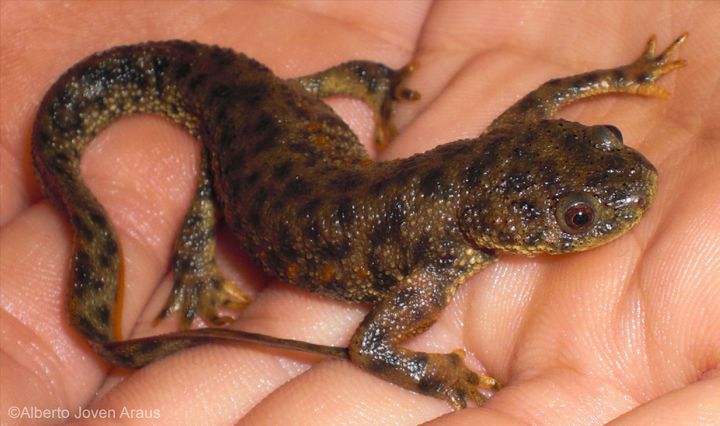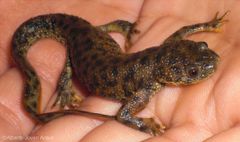Salamander genome gives clues about unique regenerative ability
[PRESS RELEASE 2017-12-22] Researchers at Karolinska Institutet have managed to sequence the giant genome of a salamander, the Iberian ribbed newt, which is a full six times greater than the human genome. Amongst the early findings is a family of genes that can provide clues to the unique ability of salamanders to rebuild complex tissue, even body parts. The study is published in Nature Communications.

This is the first time that an entire newt genome has been sequenced, an achievement that can give rise to new discoveries on the amphibian's ability to recreate brain neurons as well as entire body parts. Amongst the first findings are a multitude of copies of a certain microRNA group, which in mammals is mainly found in embryonic stem cells, but also in tumour cells.
”It will be exciting to figure out how regeneration in the adult organism re-activates embryonic genes,” says study leader Professor András Simon at Karolinska Institutet's Department of Cell and Molecular Biology. ”What's needed now are functional studies of these microRNA molecules to understand their function in regeneration. The link to cancer cells is also very interesting, especially bearing in mind newts' marked resistance to tumour formation.”
Even though the abundance of stem cell microRNA genes is quite surprising, it alone cannot explain how salamanders regenerate so well. Professor Simon predicts that the explanation lies in a combination of genes unique to salamanders and how other more common genes orchestrate and control the actual regeneration process.
One of the reasons why salamander genomes have not been sequenced before is its sheer size - six times bigger than the human genome in the case of the Iberian newt, which has posed an enormous technical and methodological challenge.
”It's only now that the technology is available to handle such a large genome,” says Professor Simon. ”The sequencing per se doesn't take that long - it's recreating the genome from the sequences that's so time consuming.”
”We all realised how challenging it was going to be,” recounts first author Ahmed Elewa, postdoctoral fellow at the same department. ”But the very fact that it was such a challenge made it all the more exciting.”
The group at Karolinska Institutet is now engaging with other researchers to discover what can be learned from the newt genome and test new hypotheses through systematic comparisons with mammals.
”We showed ten years ago that salamanders can recreate all the cells that die in Parkinson's disease in the space of four weeks,” says Professor Simon. ”We can now delve deeply into the molecular processes underlying this ability. Although we're doing basic research, our findings can hopefully lead to the development of new regenerative strategies for humans.”
The sequencing project was conducted in collaboration with SciLifeLab and Uppsala University and was largely financed with grants from the Swedish Research Council, the National Institutes of Health (USA), the European Research Council, the Swedish Cancer Society and the Wenner-Gren Foundation.
Publication: ”Reading and editing the Pleurodeles waltl genome reveals novel features of tetrapod regeneration”, Ahmed Elewa, Heng Wang, Carlos Talavera-López, Alberto Joven, Gonçalo Brito, Anoop Kumar, L Shahul Hameed, May Penrad-Mobayed, Zeyu Yao, Neda Zamani, Yamen Abbas, Ilgar Abdullayev, Rickard Sandberg, Manfred Grabherr, Björn Andersson, András Simon. Nature Communications, online 22 December 2017, doi: 10.1038/s41467-017-01964-9.
Contacts
For more information, please contact:
András Simon, Professor
Department of Cell and Molecular Biology, Karolinska Institutet
Phone: +46 73 904 40 40
Email: Andras.Simon@ki.se
Images


Karolinska Institutet is one of the world’s leading medical universities. Its vision is to significantly contribute to the improvement of human health. Karolinska Institutet accounts for the single largest share of all academic medical research conducted in Sweden and offers the country’s broadest range of education in medicine and health sciences. The Nobel Assembly at Karolinska Institutet selects the Nobel laureates in Physiology or Medicine.
Subscribe to releases from Karolinska Institutet - English
Subscribe to all the latest releases from Karolinska Institutet - English by registering your e-mail address below. You can unsubscribe at any time.
Latest releases from Karolinska Institutet - English
New method reveals how the brain and inner ear are formed3.4.2025 20:00:00 CEST | Pressmeddelande
Researchers at Karolinska Institutet have developed a method that shows how the nervous system and sensory organs are formed in an embryo. By labelling stem cells with a genetic ‘barcode’, they have been able to follow the cells’ developmental journey and discover how the inner ear is formed in mice. The discovery, published in Science, could provide important insights for future treatment of hearing loss.
Fluoride in drinking water is associated with impaired childhood cognition7.3.2025 15:30:00 CET | Pressmeddelande
Elevated concentrations of fluoride can occur in well water, and in some countries, it is added to drinking water to counteract caries in the population. A study from Karolinska Institutet in Sweden now supports a few previous studies indicating that exposure to fluoride during the fetal stage or early childhood may impair cognition in children. The study is published in the journal Environmental Health Perspectives.
Children with ARFID face increased risk of disease17.2.2025 17:00:00 CET | Pressmeddelande
Children with avoidant restrictive food intake disorder (ARFID) have an elevated risk of developing psychiatric and physical conditions, a new study from Karolinska Institutet published in JAMA Pediatrics reports. The study highlights the importance of early identification to improve care of these children.
Preterm babies receive insufficient pain management27.1.2025 15:29:17 CET | Pressmeddelande
A large proportion of babies born very early need intensive care, which can be painful. But the healthcare system fails to provide pain relief to the full extent. This is shown by the largest survey to date of pain in neonatal care, now published in the journal Pain.
New study paves way for immunotherapies tailored for childhood cancers20.1.2025 17:00:00 CET | Pressmeddelande
Researchers at Karolinska Institutet and the Astrid Lindgren Children’s Hospital in Sweden have determined how children’s immune systems react to different kinds of cancer depending on their age. The study, which is published in the journal Cell, reveals significant differences between the immune response of children and adults, and has the potential to lead to new tailored treatments for children with cancer.
In our pressroom you can read all our latest releases, find our press contacts, images, documents and other relevant information about us.
Visit our pressroom